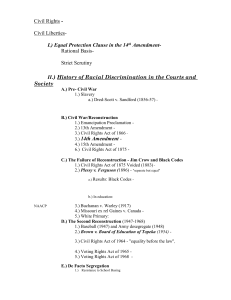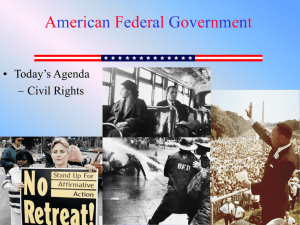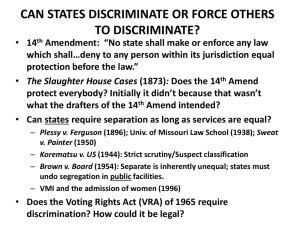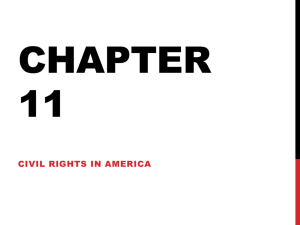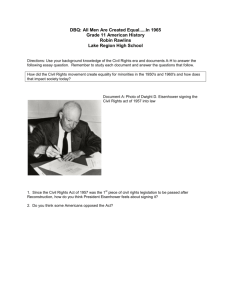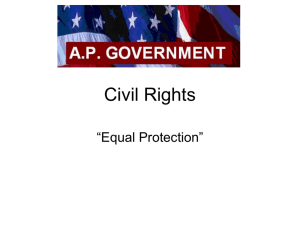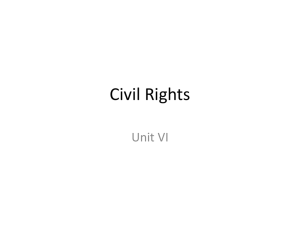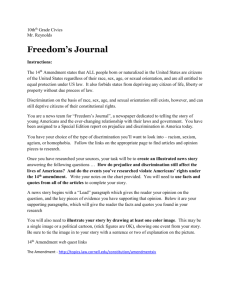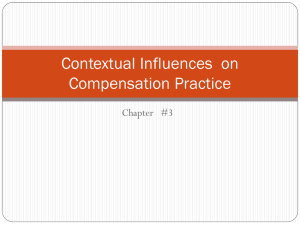Civil Rights
advertisement
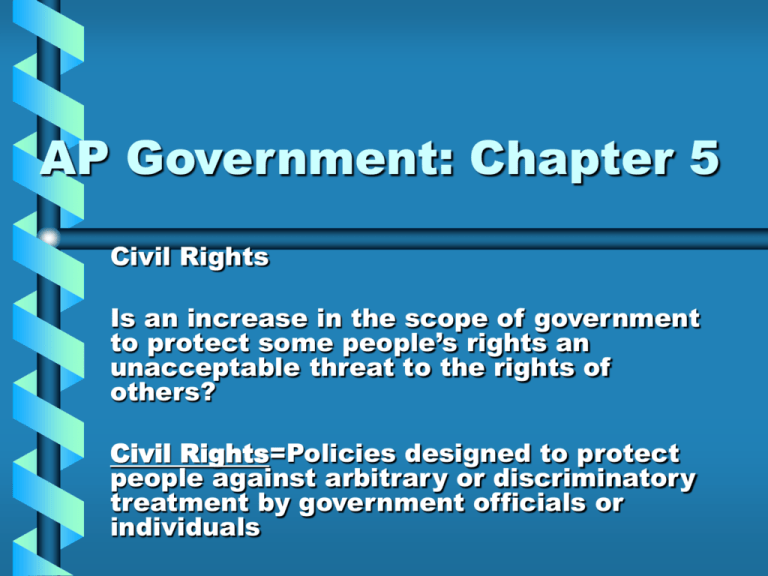
AP Government: Chapter 5 Civil Rights Is an increase in the scope of government to protect some people’s rights an unacceptable threat to the rights of others? Civil Rights=Policies designed to protect people against arbitrary or discriminatory treatment by government officials or individuals Civil Rights and Civil Liberties • Most Americans favor equality in the abstract yet the concrete struggle for equal rights under the Constitution has been our nation’s most bitter battle • Those people who enjoy privileged positions in American society have been reluctant to give them up Equality Debates Discrimination based on race, age, gender, disability, sexual orientation, and the disenfranchised Equality in the Constitution? Equality of opportunity is not in the original Constitution or the Bill of Rights • 14th Amendment (1868): forbids states from denying to anyone “equal protection of the law” The importance of the th 14 Amendment • • The Court didn’t use the amendment to create equality in society until almost 100 years later to “unshackle disadvantaged groups” Has become the vehicle for more expansive Constitutional interpretations Two centuries of Struggle th 14 Amendment: Levels of Scrutiny Three levels of scrutiny: 1. Reasonable—Bear a rational relationship to some legitimate governmental purpose are constitutional (I.e. voting age) th 14 Amendment: Levels of Scrutiny 2. Inherently Suspect— Presumed to be invalid and are upheld only if they serve a “compelling public interest” and there is no other way to accomplish the purpose of the law (I.e. college admissions, affirmative action) th 14 Amendment: Levels of Scrutiny 3. Somewhere in between— Presumed neither to be constitutional nor to be unconstitutional; a law that discriminates on the basis of gender must bear a substantial relationship to an important legislative purpose African Americans’ Struggle for Equality in America 1. The Era of Slavery • 1600’s – 1865 – Dred Scott v. Sandford (1857) • Slaves had no rights. • Invalidated Missouri Compromise – The Civil War – The Thirteenth Amendment • Ratified after Union won the Civil War • Outlawed slavery Race, the Constitution, and Public Policy 2. The Era of Reconstruction and Resegregation – Jim Crow or segregational laws • Relegated African Americans to separate facilities – Plessy v. Ferguson (1896) • Upheld the constitutionality of “equal but separate accommodations” 3. The Era of Civil Rights • Brown v. Board of Education (1954) • Overturned Plessy • School segregation inherently unconstitutional • Integrate schools “with all deliberate speed” Little Rock 9 (1957) • Civil Rights Act (1964) • Voting Rights Act of 1965 • School Busing (1971) – Busing of students solution for two kinds of segregation: • de jure, “by law” • de facto, “in reality” Civil Rights Act of 1964 • Made racial discrimination illegal in hotels, motels, restaurants, and other places of public accommodation • Forbade discrimination in employment on the basis of race, color, national origin, religion or gender • Created the (EEOC) Equal Employment Opportunity Commission to monitor and enforce protections against job discrimination • Provided for withholding federal grants from state and local governments and other institutions that practiced racial discrimination • Strengthened voting rights legislation • Authorized the US Justice Department to initiate lawsuits to desegregate public schools and facilities Voting Rights Act of 1965 • A law designed to help end formal and informal barriers to African American suffrage. • Hundreds of thousands of African Americans were registered, and the number of African American elected officials increased dramatically. Getting and Using the Right to Vote – Suffrage: the legal right to vote – Fifteenth Amendment: extended suffrage to African Americans – Poll Taxes: small taxes levied on the right to vote – White Primary: Only whites were allowed to vote in the party primaries. Getting and Using the Right to Vote – Smith v. Allwright (1944): ended white primaries – Twenty-fourth Amendment: eliminated poll taxes for federal elections – Harper v. Virginia State Board of Elections (1966): no poll taxes at all – Voting Rights Act of 1965: helped end formal and informal barriers to voting Civil Rights Amendments LIST AND ANALYZE: • 13th: • 14th: • 15th: • 19th: • 24th: Major Minorities in the United States • Caucasians=69% • Hispanic Americans=13% • African Americans=12% • Asian Americans=4% • Native Americans=1% • The United States is heading to a Minority Majority=there will be more minorities than Caucasians in your lifetime Women and the Constitution • Craig V. Boren (1976) 19th Amendment (1920) • Equal Rights Amendment (ERA) Congress passed in 1972 but it was three states short by the expiration in 1982 • Reed V. Reed (1971) Any arbitrary gender based classification violated the 14th Amend • First time declared any law unconstitutional on basis of gender discrimination “medium scrutiny” standard established • Gender discrimination neither valid nor invalid • Court said there must be an “exceedingly persuasive justification” for any government to classify people by gender • Civil Rights Act (1964) banned gender discrimination in employment • Women in the Workplace – The Civil Rights Act of 1964 banned gender discrimination in employment. • Wage Discrimination and Comparable Worth – The Supreme Court has not ruled on this issue. • Women in the Military – Only men may be drafted or serve in ground combat. • Sexual Harassment – Prohibited by Title VII of Civil Rights Act of 1964 Women’s Laws • Title IX of the Education Act of 1972 • Pregnancy Discrimination Act of 1978: forbids gender discrimination in federally subsidized education programs • 1996 Supreme Court decided that single gender schooling violates women’s right to equal protection of the law Women in the Military • Women are now part of the regular service since 1975 • Make up 15% in the Armed forces • Discrepancies: 1. Only men must register for the draft 2. Prohibits women from serving in combat (today=no ground combat in Army and Marines) Newly Active Groups under Civil Rights • Gray Liberation Movement • People with Disabilities • Gay and Lesbian Rights Groups How has civil rights helped these groups? Gay and Lesbian Rights – Bowers v. Hardwick (1986) – Lawrence v. Texas (2003) • Overturned Bowers • Private homosexual acts are protected by the Constitution – Gay marriage • Many state constitutions amended to prohibit practice Affirmative Action… A Policy designed to give special attention to or compensatory treatment for members of some previously disadvantaged group • According to the Supreme Court, is affirmative action constitutional? • In education – Regents of the University of California v. Bakke (1978) • Racial set asides unconstitutional • Race could be considered in admissions – Grutter v. Bollinger (2003) • Race could be considered a “plus” in admissions Affirmative Action… • In employment – United Steelworks v. Weber (1979) • Quotas to remedy past discrimination are constitutional. – Adarand Constructors v. Pena (1995) • To be constitutional, affirmative action must be “narrowly tailored” to meet a “compelling governmental interest.” • Did not ban affirmative action, but severely limited its reach
